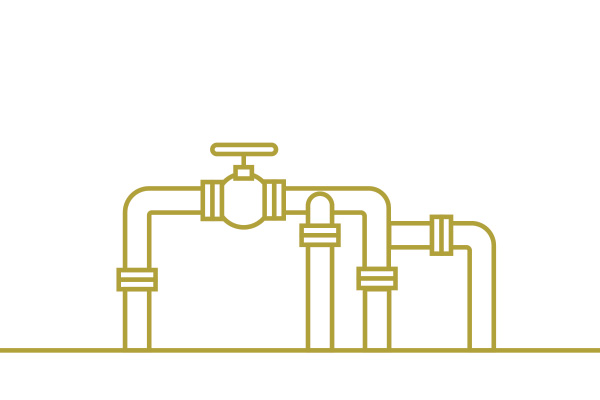The Water Infrastructure Fund (WIF) will make investments to support innovative projects across the state with the goal of protecting, preserving and restoring Iowa’s water resources. Eligible projects will be primarily water quality improvement, but may provide a number of other benefits such as:

Economically Significant Projects

Watershed Protection Projects

Industrial Water Reuse/Conservation Projects (Pilot)

Wastewater Infrastructure for Unsewered Communities
IFA reserves the right to adjust program terms and materials as needed.
The U.S. Department of the Treasury’s guidance aligns eligible water infrastructure projects with the Environment Protection Agency’s (EPA) Clean Water State Revolving Fund and Drinking Water State Revolving Fund’s list of eligible projects.
Please refer to the application and term sheets for each category for more details regarding project and applicant eligibility
Smart, strategic infrastructure investments can be a catalyst for economic growth. A water infrastructure project is “economically significant” to the state if it serves a large population or geography, with the added benefits of promoting tourism and/or supporting economic growth (jobs created, increase local revenue, etc.).
Examples of how to measure the “economic significance” of a project could include estimating the population or geography served by the project, the number of jobs expected to be created and/or supported by the project, the anticipated amount of increased tax revenue resulting from the project, and so on.
Funding is no longer available for this project category, as of Jan. 31, 2022.
Nonpoint source pollution is the largest contributor of water pollution in Iowa, placing many of our streams and lakes on the Impaired Waters List. The Water Infrastructure Fund will invest in nonpoint source watershed projects that improve Iowa’s water quality, focusing on green infrastructure and measures to control nonpoint source pollution from hydromodification.
Funding is no longer available for this project category, as of Feb. 16, 2022.
As our state faces increasingly frequent and unpredictable adverse weather events such as severe drought, conserving our water resources has never been more important. Industrial and manufacturing facilities often use a large amount of our water resources in their processes and send millions of gallons of effluent to the local utility for treatment.
The Water Infrastructure fund will provide matching grants for manufacturers to install onsite water reuse systems at industrial and/or manufacturing facilities. These systems will reduce the heavy demand placed on our surface and ground water resources and will lessen the local utility’s need to treat wastewater that is used for industrial purposes.
Iowa has approximately 460 communities in 92 counties that are considered unsewered, many of whom face environmental and public health risks. WIF will provide grants for property-owners residing in an unsewered community to repair or upgrade their septic system. A portion of funding will also be reserved to provide financial assistance to unsewered communities to implement an existing plan for constructing a centralized wastewater system.
Property Owner – Onsite Wastewater Systems in Unsewered Communities
Program Eligibility and Instructions
Grant Application (Please note: you must apply through your county sanitarian)
Applications are no longer being accepted from homeowners as of April, 30, 2022.
For inquiries about the Water Infrastructure Fund contact the Water Infrastructure Team.
WIF is funded by the state of Iowa’s allocation of Coronavirus State and Local Fiscal Recovery Funds from the American Rescue Plan Act (“ARPA”), which was signed into law by President Biden on March 11, 2021.
It is important to note that this funding is separate and independent from any provisions resulting from the federal Infrastructure Investment and Jobs Act (the “Bipartisan Infrastructure Law”), which was passed by Congress and signed into law on November 15, 2021.
Yes, but only for the eligible part of the project. According to U.S. Treasury guidance, ARPA funds must be obligated by December 31, 2024 and spent by December 31, 2026. Out of an abundance of caution, IFA will require WIF recipients to attest that construction of the project will be completed by June 30, 2026.
Generally, no. However, projects over $10 million are subject to reporting guidelines similar to the Davis-Bacon Act (“Davis-Bacon”) requirements. Additionally, National Environmental Policy Act (“NEPA”) and American Iron and Steel (“AIS”) compliance are not required for projects funded only by State and Local Fiscal Recovery Funds (Water Infrastructure Fund). However, if the funds are used in conjunction with other funds that are subject to Davis-Bacon, NEPA, and/or AIS requirements, then the project is subject to those requirements as well.
Please refer to the Term Sheets for each category for details such as the overall amount allotted to the category, how much is available per project, match requirements, application and scoring guidelines and more.
Please refer to the Term Sheets for each category for details such as the overall amount allotted to the category, how much is available per project, match requirements, application and scoring guidelines and more.
Please refer to the Term Sheets for each category for details such as the overall amount allotted to the category, how much is available per project, match requirements, application and scoring guidelines and more.
Please refer to the Term Sheets for each category for details such as the overall amount allotted to the category, how much is available per project, match requirements, application and scoring guidelines and more.
A water infrastructure project is “economically significant” to the state if it serves a large population or geography), with the added benefits of promoting tourism and/or supporting economic growth.
Examples of how to measure the “economic significance” of a project could include estimating the population or geography served by the project, the number of jobs expected to be created and/or supported by the project, the anticipated amount of increased tax revenue resulting from the project, and so on.
“Project” generally refers to the specific phase of work being funded by WIF.
There are instances where reference may be made to “overall project”. This would mean all expected phases of a total project since WIF may be limited to funding a certain portion or phase.
Generally, no. WIF will initially focus on funding four main initiatives (categories):
• Economically Significant Water Infrastructure Projects
• Watershed Protection Projects
• Industrial Water Reuse Projects
• Water Infrastructure for Unsewered Communities
One instance where WIF may be combined with SRF (or USDA) is if you are an unsewered community wishing to implement an existing (current) plan to construct or connect to a centralized wastewater system. In this case, WIF grants may be used to reduce the overall cost of the project.
The U.S. Treasury is expected to provide final guidance and instructions on reporting requirements soon. Until then, please refer to the State and Local Fiscal Recovery Funds Compliance and Reporting Guidance published on November 15, 2021 by the U.S. Treasury (Version 2.1) and/or the Interim Final Rule.
As of now, WIF grant recipients will be required to provide quarterly updates on the status of the project’s construction/completion. IFA will require a final report to be submitted once construction is complete and the project is functioning/in operation. This can be a formal “works in operation” document or an attestation form.
If the construction of a project is not completed by June 30, 2026, IFA will de-obligate any unspent WIF commitments and you will need to fund the completion of the project in another way.